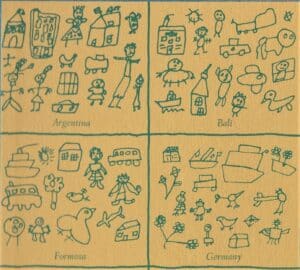 I read Rhoda Kellogg’s book The Psychology of Child’s Art when I was teaching Montessori art in the Children’s Studio. The environment was a grant funded program I created for neighborhood children ages four through nine. I noticed that many of the reproductions of children’s paintings in the book looked like paintings done by contemporary artists of the 60’s and 70’s. I made a slide presentation using images from her book and images of adult artists that were very similar to the children’s work. They were shown on a desk top slide viewer with a projector which the children could operate. The children were asked to identify each painting as being created either by an adult or by a child. Several comparisons were visually very close. The children only made one missed call. A drawing done by Jean Dubuffet fooled the children. Dubuffet studied children’s art and was influenced by their visual means of expression.
I read Rhoda Kellogg’s book The Psychology of Child’s Art when I was teaching Montessori art in the Children’s Studio. The environment was a grant funded program I created for neighborhood children ages four through nine. I noticed that many of the reproductions of children’s paintings in the book looked like paintings done by contemporary artists of the 60’s and 70’s. I made a slide presentation using images from her book and images of adult artists that were very similar to the children’s work. They were shown on a desk top slide viewer with a projector which the children could operate. The children were asked to identify each painting as being created either by an adult or by a child. Several comparisons were visually very close. The children only made one missed call. A drawing done by Jean Dubuffet fooled the children. Dubuffet studied children’s art and was influenced by their visual means of expression.
I next read Kellogg’s book Analyzing Children’s Art. The author was teacher and a psychologist who taught young children in California. She lectured, traveled and collected children’s art from all over the world. The end papers at the front and back of the book illustrate childrens’ drawings from 23 different countries. The similarity of drawings from children around the world is striking.
My interest as an art teacher was drawn to her documentation of the twenty basic scribbles found in young children’s art. Ms. Kellogg describes these markings as the building blocks of art. Where a child places their scribbles is called a placement pattern. There are seventeen placement patterns. I made matching games using the 20 scribble patterns and 17 placement patterns for the visual thinking shelf.
I found an interesting deck of large, over sized cards called “The Shuffle Book.” Each side had a simple design that illustrated the word at the top of the card. The words were a single noun, a verb or adjective. The child was to shuffle the cards and lay them out to form simple sentences or a very short story.
The cards were created by a graphic designer(s). The designs were simple and direct. Most exciting was the fact that I could find an image for each of the placement patterns. I made and presented placement pattern cards to my 9-12 classes then gave a few shuffle cards to every two or three students. They were to the match the graphic design of a card to the placement pattern it illustrated. The presentation was a success. The cards were taken off the shelf and enjoyed. I have not been able to find a source for the original shuffle book or even a used copy of it.
